
Fife is a council area, historic county, registration county and lieutenancy area of Scotland. It is situated between the Firth of Tay and the Firth of Forth, with inland boundaries with Perth and Kinross and Clackmannanshire. By custom it is widely held to have been one of the major Pictish kingdoms, known as Fib, and is still commonly known as the Kingdom of Fife within Scotland. A person from Fife is known as a Fifer. In older documents the county was very occasionally known by the anglicisation Fifeshire.

Blackness Castle is a 15th-century fortress, near the village of Blackness, Scotland, on the south shore of the Firth of Forth.
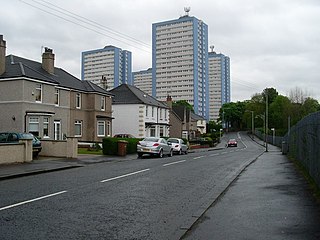
Sandyhills is an area of the Scottish city of Glasgow. It is situated north of the River Clyde and has fallen within the Shettleston ward of Glasgow City Council since 2007.

Armadale is a town within the county of West Lothian in the Central Belt of Scotland. It lies to the west of Bathgate and to the east of Blackridge. Armadale, formerly known as Barbauchlaw, is an ex-mining town which was also known for its brick manufacturing. It is named after Armadale in Sutherland, this estate being owned by Sir William Honeyman who later acquired the land of Barbauchlaw. Primarily a residential community, the town has a number of different public places, a central Mains Street and a series of parks, green spaces and nature reserves, many of which lie atop former mines and industrial areas.
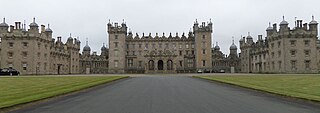
Floors Castle, in Roxburghshire, south-east Scotland, is the seat of the Duke of Roxburghe. Despite its name it is an estate house rather than a fortress. It was built in the 1720s by the architect William Adam for Duke John, possibly incorporating an earlier tower house. In the 19th century it was embellished with turrets and battlements, designed by William Playfair, for The 6th Duke of Roxburghe. Floors has the common 18th-century layout of a main block with two symmetrical service wings. Floors Castle stands by the bank of the River Tweed and overlooks the Cheviot Hills to the south.

The Bishop's Castle was a medieval castle in Glasgow, Scotland. It stood to the west of Glasgow Cathedral, covering much of the present day Cathedral Square. The castle served as the residence of the Archbishops of Glasgow until 1689. Following the Glorious Revolution, the castle became the property of the Crown. It fell into disrepair during the 18th century, having been used as a quarry from 1755, and the site was cleared in 1789 to make way for the Glasgow Royal Infirmary.

MacLellan's Castle in the town of Kirkcudbright, in Galloway, Scotland, was built in the late 16th century. It stands in the centre of Kirkcudbright, on the south side of the River Dee which flows into the Solway Firth. The L-plan castle was the residence of the MacLellan family from whom it derived its name. The family sold the castle in 1752, and from 1782 to 1912 it was held by the Earls of Selkirk. Today, the site is in the care of Historic Environment Scotland.

Linlithgow is a town in West Lothian, Scotland. It was historically West Lothian's county town, reflected in the county's historical name of Linlithgowshire. An ancient town, it lies in the Central Belt on a historic route between Edinburgh and Falkirk beside Linlithgow Loch. The town is situated approximately 20 miles (32 km) west of Edinburgh.
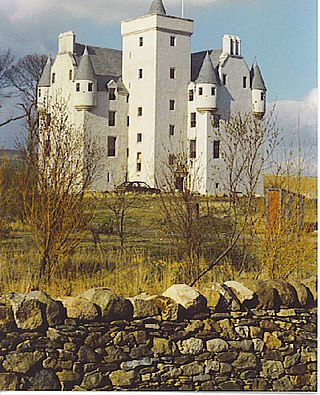
Leslie Castle is a castle in Aberdeenshire, Scotland, the historical seat of Clan Leslie, located just to the west of Auchleven, or about 45 kilometres (28 mi) northwest of Aberdeen.

Bavelaw Castle is a historic house in the City of Edinburgh Council area, Scotland. It is north of Hare Hill in the Pentland Hills, four miles west of Penicuik, and two miles south of Balerno, above Threipmuir Reservoir. It was designated as a Category A listed building in 1971.

Barnbougle Castle is a historic tower house on the southern shore of the Firth of Forth, between Cramond and Queensferry, and within the parish of Dalmeny. It lies within the Earl of Rosebery's estate, just north-west of Dalmeny House. Although its history goes back to the 13th century, the present castle is the result of rebuilding in 1881 by the 5th Earl of Rosebery, who served as Prime Minister from 1894 to 1895.
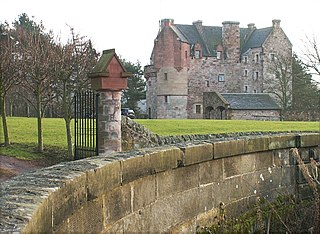
Dairsie Castle is a restored tower house located 1.3 kilometres (0.81 mi) south of Dairsie in north-east Fife, Scotland. The castle overlooks the River Eden.

Cluny Castle was originally built c.1604 as a Z-plan castle replacing either a house or small peel tower. Sited in the parish of Cluny, it is south of Monymusk and north of Sauchen in Aberdeenshire, north-east Scotland. Owned by three separate branches of Gordon families over the centuries, it was used to shelter Jacobite rebels in the mid-18th century. Extensive additions were made in 1820 to the design of architect John Smith when it was in the ownership of Colonel John Gordon. Two wings of the castle and the adjoining private chapel were destroyed by fire in 1926, but the damage was restored.

Robert Philip Andrew Hurd was an influential conservation architect. His original aim was to be an architectural author specialising in traditional forms. He came to Scotland in 1930 and worked at the Edinburgh College of Art for two years as assistant to the architect and planner Frank Mears. He was an early and highly respected conservation architect and wrote and broadcast on Scottish architecture, planning and reconstruction.
John Douglas of Pinkerton was a Scottish architect who designed and reformed several country houses in the Scottish Lowlands. His work deserves to be noted for what the 2002 history of Scottish architecture remarks as an approach "of relentless surgery or concealment.". His most notable works are Killin and Ardeonaig Church, Stirlingshire (1744); Archerfield House, East Lothian (1745); Finlaystone House, Renfewshire (1746–47), Wardhouse (Gordonhall), Insch, Aberdeenshire (1757); and Campbeltown Town Hall, Argyll and Bute (1758–60). Several of these are listed buildings.

Raith, as an area of Fife, once stretched from the lands of Little Raith, south of Loch Gelly, as far as Kirkcaldy and the Battle of Raith was once theorised to have been fought here in 596 AD. Raith Hill, west of Auchtertool and immediately to the east of the Mossmorran fractionation plant, may also be in reference to this wider area or may refer to an actual fort on this hill, distinct to the one naming the area.
Stuart Lowe Harris was a Scottish architect and historian. He worked for 34 years in the Architects Department of Edinburgh Council, where he rose to the post of Depute City Architect. He was responsible for several notable public building projects, including the Meadowbank Sports Centre and the failed plan to build an opera house in the city. He was deeply interested in local Edinburgh history, and published several books and many articles on the subject, including a definitive work on the origins of local place names.
Walter Schomberg Hepburn Scott (1910–1998) was a Scottish architect specialising in building restoration. From 1950 to 1975, he did multiple projects for the National Trust of Scotland.
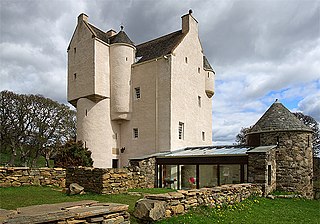
Muckrach Castle, also known as Muchrach or Muckerach Castle, is a tower house near the Scottish town of Dulnain Bridge in the Highland council area. It was built in 1598 as the original seat of Grants of Rothiemurchus, with timber used as part of the stone walls. It was unroofed in 1739 and remained runious until the 20th century. In 1971 the building was added to the Scottish monument lists in the highest monument category A, before being restored by the architect Ian Begg in 1978–85. It is since used as holiday apartments.


















